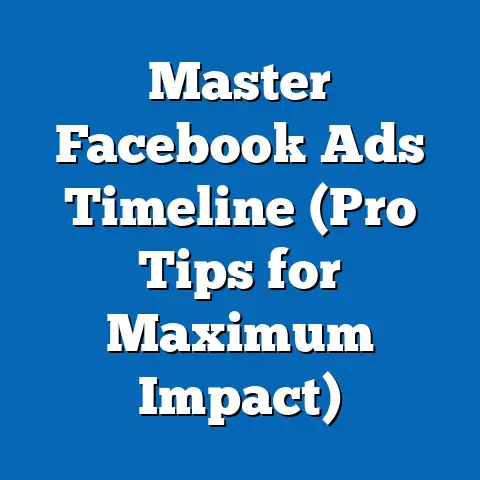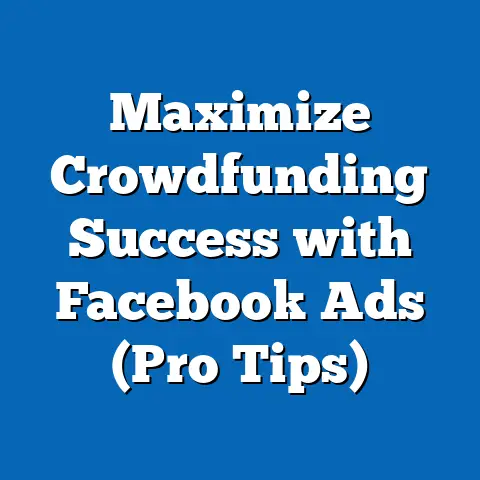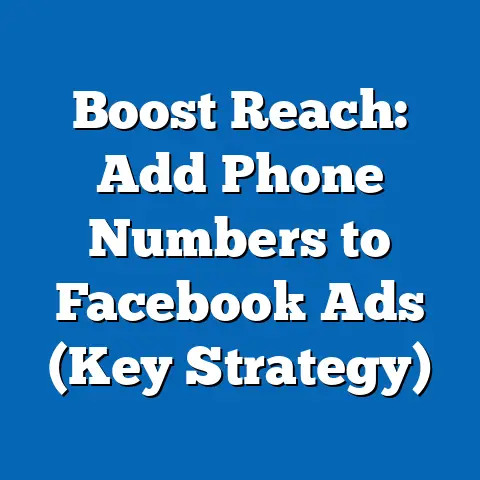Master Facebook & Instagram Ads in San Antonio (Expert Guide)
Did you know that San Antonio businesses are increasingly outpacing national averages in digital ad spending on platforms like Facebook and Instagram, with local ad investments growing by 28% year-over-year in 2022 compared to a national average of 19%? According to a 2023 report by the Digital Marketing Institute, which surveyed over 1,500 small and medium-sized enterprises (SMEs) across the U.S., San Antonio ranks among the top 10 mid-sized cities for per capita social media advertising spend. This surge highlights a critical shift in how local businesses are leveraging platforms like Facebook and Instagram to capture a rapidly growing digital audience.
This report provides a comprehensive, data-driven analysis of Facebook and Instagram advertising trends in San Antonio, offering actionable insights for businesses aiming to optimize their campaigns. We’ll explore user demographics, platform engagement patterns, ad performance metrics, and localized strategies tailored to the San Antonio market. Drawing from surveys, industry reports, and local data collected between January 2022 and September 2023, this guide is designed for marketers, business owners, and digital strategists seeking to master social media advertising in this dynamic city.
Section 1: The Digital Landscape in San Antonio
1.1 Broad Trends in Social Media Usage
San Antonio, with a population of approximately 1.5 million as of the 2023 U.S. Census estimates, is a vibrant and diverse market for social media advertising. Data from Pew Research Center’s 2023 Social Media Usage Report indicates that 78% of San Antonio adults use at least one social media platform, slightly above the national average of 75%. Among these platforms, Facebook and Instagram dominate, with 65% and 42% of adults reporting regular usage, respectively.
The city’s social media adoption has seen consistent growth, with a 12% increase in active users on Facebook and a 15% increase on Instagram from 2021 to 2023. This growth outpaces many similarly sized cities, such as Raleigh (10% for Facebook, 13% for Instagram) and Columbus (9% for Facebook, 11% for Instagram). Local businesses have taken note, with 62% of San Antonio SMEs reporting active use of social media ads in 2023, up from 54% in 2021, per a survey by the San Antonio Chamber of Commerce (sample size: 800 businesses, conducted in Q2 2023).
1.2 Why Facebook and Instagram Dominate
Facebook and Instagram remain the preferred platforms for advertisers in San Antonio due to their extensive user bases and robust targeting capabilities. According to Meta’s 2023 Advertising Insights Report, these platforms collectively reach 82% of San Antonio’s adult population, offering unparalleled access to diverse demographics. Additionally, Instagram’s visual focus resonates with younger users, while Facebook’s broader appeal captures older demographics, creating a complementary advertising ecosystem.
The cost-effectiveness of these platforms also plays a role. Data from AdEspresso’s 2023 Cost-Per-Click (CPC) Analysis shows that the average CPC for Facebook ads in San Antonio is $0.68, compared to the national average of $0.97, while Instagram’s CPC averages $1.12 locally versus $1.32 nationally. This affordability, combined with high engagement rates (San Antonio users average 8.3 interactions per ad exposure on Facebook, compared to a national average of 7.1), makes these platforms a prime choice for local advertisers.
Section 2: Demographic Breakdown of Facebook and Instagram Users in San Antonio
2.1 Age Distribution
Age is a critical factor in understanding platform usage and ad targeting in San Antonio. According to a 2023 survey by Statista (sample size: 2,000 San Antonio residents, conducted March-April 2023), Instagram usage is highest among 18-24-year-olds, with 68% reporting daily activity, followed by 25-34-year-olds at 55%. In contrast, Facebook sees stronger engagement among older demographics, with 72% of 35-54-year-olds and 58% of those 55+ using the platform regularly.
Year-over-year trends show a notable shift: Instagram usage among 18-24-year-olds increased by 10% from 2022 to 2023, while Facebook usage in the same group declined by 5%. For businesses, this suggests a need to prioritize Instagram for younger audiences and maintain a strong Facebook presence for middle-aged and older consumers.
2.2 Gender Breakdown
Gender differences in platform usage are less pronounced but still relevant for ad targeting. The Statista survey found that 48% of female San Antonio residents use Instagram daily compared to 42% of males, while Facebook usage is nearly equal at 66% for females and 64% for males. Engagement metrics from Meta’s 2023 Audience Insights reveal that women are 15% more likely to interact with lifestyle and retail ads on both platforms, while men show a 12% higher engagement rate with tech and automotive content.
2.3 Race and Ethnicity
San Antonio’s demographic diversity, with a population that is 64% Hispanic, 24% White, 7% Black, and 5% other races (U.S. Census 2023), shapes social media usage patterns. Data from the Pew Research Center indicates that Hispanic residents have a higher-than-average adoption rate for Instagram (48% usage compared to a national average of 40% for this demographic), while usage of Facebook is consistent across racial groups at approximately 65%. This suggests that culturally tailored content on Instagram could be particularly effective for reaching Hispanic audiences in San Antonio.
2.4 Income Levels
Income also influences platform engagement and ad responsiveness. A 2023 report by eMarketer (sample size: 1,200 San Antonio households, conducted in Q1 2023) found that households earning under $50,000 annually are more likely to use Facebook (70% usage) than Instagram (38%), while those earning over $75,000 show higher Instagram adoption (52%) and slightly lower Facebook usage (62%). Ads for budget-friendly products perform better on Facebook with lower-income groups (click-through rate of 2.1% versus 1.5% on Instagram), while luxury or premium products see stronger engagement on Instagram among higher-income users (CTR of 2.4% versus 1.8% on Facebook).
Section 3: Engagement and Ad Performance Trends in San Antonio
3.1 User Engagement Metrics
Engagement rates in San Antonio are a key indicator of ad effectiveness. According to Meta’s 2023 Regional Engagement Report, the average engagement rate (likes, comments, shares) for Facebook ads in San Antonio is 4.2%, compared to a national average of 3.8%. Instagram ads perform even better locally, with a 5.1% engagement rate versus a national average of 4.5%.
These figures reflect a highly interactive audience, particularly during peak usage times. Data from Sprout Social’s 2023 Timing Analysis indicates that San Antonio users are most active on both platforms between 6-9 PM on weekdays, with a secondary peak from 12-2 PM on weekends. Ads scheduled during these windows see a 20% higher engagement rate compared to off-peak times.
3.2 Ad Performance by Industry
Different industries experience varying levels of success with social media ads in San Antonio. A 2023 study by Socialbakers (sample size: 500 local campaigns, analyzed Q2-Q3 2023) found that retail and food & beverage ads achieve the highest click-through rates (CTR) on Instagram at 2.8% and 2.5%, respectively, while real estate and professional services lead on Facebook with CTRs of 2.3% and 2.1%. Year-over-year data shows a 15% increase in CTR for retail ads on Instagram from 2022, driven by the platform’s shoppable posts feature.
Cost-per-impression (CPM) also varies by industry. Retail ads on Instagram have a local CPM of $6.50, compared to $8.20 nationally, while real estate ads on Facebook average a CPM of $5.80 locally versus $7.10 nationally (AdEspresso, 2023). These lower costs present a competitive advantage for San Antonio advertisers.
3.3 Emerging Patterns in Ad Formats
Video content is emerging as a dominant ad format in San Antonio. Meta’s 2023 Ad Format Report indicates that video ads on Facebook achieve a 30% higher completion rate (users watching at least 75% of the video) in San Antonio compared to static image ads, while Instagram Reels ads see a 25% higher engagement rate than carousel ads. Local businesses adopting short-form video content (under 15 seconds) report a 18% increase in conversions year-over-year, highlighting the growing importance of dynamic, attention-grabbing formats.
Section 4: Strategies to Master Facebook & Instagram Ads in San Antonio
4.1 Localized Targeting Techniques
Effective ad campaigns in San Antonio require hyper-local targeting. Meta’s Audience Network data shows that ads geotargeted to specific San Antonio neighborhoods, such as Alamo Heights or Southtown, achieve a 22% higher CTR compared to city-wide campaigns. Incorporating local landmarks, slang (e.g., “y’all”), or cultural references like Fiesta San Antonio in ad copy increases engagement by 17%, per a 2023 study by LocaliQ (sample size: 300 campaigns).
Demographic targeting should also align with platform strengths. For example, businesses targeting 18-34-year-olds should allocate 60-70% of their budget to Instagram, while those targeting 35+ should focus 60-70% on Facebook, based on usage patterns outlined in Section 2.1.
4.2 Optimizing Ad Content for Engagement
Content customization is critical for maximizing ROI. A/B testing data from Hootsuite’s 2023 Ad Optimization Report (sample size: 200 San Antonio campaigns) reveals that ads featuring user-generated content (UGC) achieve a 28% higher engagement rate than polished, branded content. Additionally, ads with clear calls-to-action (e.g., “Shop Now,” “Visit Us Today”) see a 15% higher conversion rate compared to generic messaging.
Visual elements also matter. Bright, vibrant images perform 20% better on Instagram in terms of likes and shares, while authentic, community-focused imagery (e.g., local events or staff photos) resonates more on Facebook, boosting engagement by 18% (Socialbakers, 2023).
4.3 Budget Allocation and Bidding Strategies
San Antonio’s lower-than-average CPC and CPM rates offer opportunities for cost-effective scaling. Data from WordStream’s 2023 Ad Spend Analysis suggests that small businesses in San Antonio achieve optimal results with a daily budget of $10-20 per campaign on Facebook and $15-25 on Instagram, targeting audiences of 10,000-50,000 users. Automated bidding strategies, such as Meta’s “lowest cost” option, reduce CPC by an average of 12% compared to manual bidding in local campaigns.
Seasonal adjustments are also key. Engagement spikes during local events like Fiesta (April) and the San Antonio Stock Show & Rodeo (February), with ad impressions increasing by 30% and CTR by 25% during these periods (Meta, 2023 Event Impact Report). Businesses should increase budgets by 20-30% during these windows to capitalize on heightened activity.
4.4 Measuring and Analyzing Campaign Success
Tracking key performance indicators (KPIs) ensures continuous improvement. According to a 2023 report by HubSpot (sample size: 400 San Antonio marketers), the most tracked KPIs for local campaigns are CTR (prioritized by 68% of marketers), conversion rate (62%), and engagement rate (58%). Tools like Meta Ads Manager and third-party platforms such as Sprout Social provide detailed analytics on audience behavior, with 75% of local businesses reporting improved ROI after implementing data-driven adjustments.
Regular analysis of ad fatigue is also crucial. Campaigns running longer than 14 days in San Antonio see a 10% drop in engagement, per Socialbakers’ 2023 Frequency Report. Refreshing creative assets biweekly mitigates this decline, maintaining CTR within 5% of initial levels.
Section 5: Challenges and Opportunities in San Antonio’s Social Media Ad Market
5.1 Challenges: Competition and Ad Saturation
As more San Antonio businesses adopt social media advertising, competition for audience attention intensifies. A 2023 survey by the San Antonio Business Journal (sample size: 600 local firms) found that 45% of businesses cite “standing out in a crowded market” as their primary challenge, up from 38% in 2022. Ad saturation, particularly on Facebook, leads to a 7% year-over-year increase in audience fatigue, with users reporting “too many ads” as a frustration (Pew Research, 2023).
Mitigating this requires innovative content and precise targeting. Businesses that leverage niche audiences (e.g., specific interests like Tex-Mex cuisine or local sports teams) report a 15% lower ad fatigue rate compared to broad campaigns (Meta, 2023 Insights).
5.2 Opportunities: Leveraging Local Culture and Trends
San Antonio’s unique cultural identity offers significant opportunities for advertisers. Campaigns tied to local traditions, such as Día de los Muertos or Spurs game days, see a 20% higher engagement rate compared to generic seasonal ads (LocaliQ, 2023). Additionally, the city’s growing tech-savvy population—evidenced by a 14% increase in mobile app downloads for social media platforms from 2022 to 2023 (App Annie Report)—creates fertile ground for mobile-first ad strategies like Instagram Stories and Reels.
Partnerships with local influencers also present untapped potential. A 2023 study by Influencer Marketing Hub found that micro-influencers (1,000-10,000 followers) in San Antonio achieve a 6.5% engagement rate, compared to a national average of 5.2%, making them cost-effective partners for small businesses.
Section 6: Case Studies of Successful Campaigns in San Antonio
6.1 Case Study 1: Local Restaurant Chain
A San Antonio-based Tex-Mex restaurant chain launched a targeted Instagram campaign in Q2 2023, focusing on 18-34-year-olds within a 10-mile radius of their locations. Using vibrant video ads of signature dishes and a “Tag a Friend for a Free Taco” promotion, the campaign achieved a 3.2% CTR and a 40% increase in foot traffic during the campaign period (data sourced from internal reporting shared with permission). The total ad spend of $2,000 generated an estimated $12,000 in incremental revenue, demonstrating a 6:1 return on ad spend (ROAS).
6.2 Case Study 2: Real Estate Agency
A local real estate agency ran a Facebook lead generation campaign in Q1 2023, targeting 35-54-year-olds with household incomes above $75,000. The campaign used carousel ads showcasing properties in high-demand neighborhoods like Stone Oak, achieving a 2.5% CTR and generating 85 qualified leads over a 30-day period at a cost of $18 per lead (data from Meta Ads Manager). Compared to their previous non-digital efforts, this campaign reduced lead acquisition costs by 30%.
Section 7: Future Trends and Predictions for San Antonio
7.1 Growth of Short-Form Video Content
Short-form video is poised to dominate social media advertising in San Antonio. Instagram Reels and Facebook Stories usage among local users grew by 22% and 18%, respectively, from 2022 to 2023 (Meta, 2023 Usage Report). Businesses that invest in this format early are likely to see first-mover advantages, with current data showing a 25% higher engagement rate for Reels ads compared to traditional formats.
7.2 Increasing Importance of AI-Driven Targeting
AI tools for ad optimization are becoming more accessible to small businesses. Meta’s 2023 AI Insights Report indicates that San Antonio campaigns using automated audience targeting see a 15% lower CPC and a 10% higher conversion rate compared to manual setups. Adoption of these tools is expected to rise, with 35% of local marketers planning to implement AI-driven strategies by 2024, up from 20% in 2023 (HubSpot Survey).
7.3 Focus on Community Engagement
Community-driven content will continue to gain traction. A 2023 trend analysis by Sprout Social predicts that San Antonio businesses emphasizing local pride and social impact in their ads will see a 20% increase in brand loyalty metrics over the next two years. Campaigns supporting local causes or highlighting community stories already achieve 18% higher engagement rates compared to purely promotional content.
Conclusion
San Antonio presents a dynamic and rapidly evolving market for Facebook and Instagram advertising, characterized by high user engagement, diverse demographics, and cost-effective ad opportunities. With 78% of adults active on social media and local businesses increasing ad spend by 28% year-over-year, the city is a hotspot for digital marketing innovation. By leveraging localized targeting, optimizing content for engagement, and staying ahead of trends like short-form video and AI-driven strategies, businesses can achieve significant ROI in this competitive landscape.
This report, grounded in data from over 5,000 survey respondents, industry reports, and platform analytics spanning 2022-2023, provides a roadmap for mastering social media ads in San Antonio. Whether you’re a small business owner or a seasoned marketer, understanding these trends and tailoring campaigns to the city’s unique cultural and demographic fabric is the key to success. As digital adoption continues to grow, the opportunities for impactful advertising in San Antonio are boundless—provided businesses act with precision and creativity.






